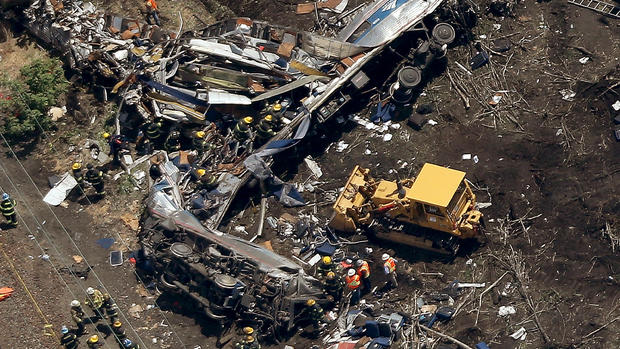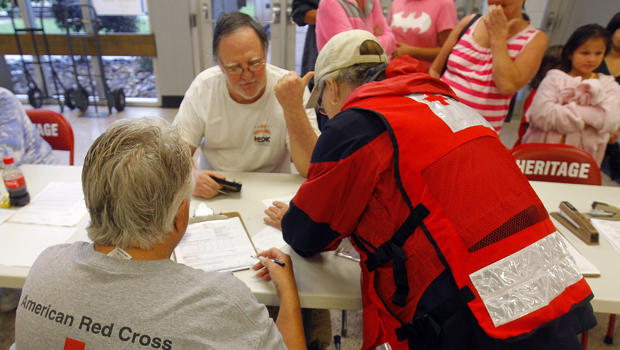Residents displaced by Tenn. derailment get good news
MARYVILLE, Tenn. -- Thousands of eastern Tennessee residents were returning home Friday after they were evacuated when a CSX train car carrying hazardous material derailed and caught fire.
An evacuation order has been lifted for about 5,000 people who live within a mile-and-a-half radius of the crash site, Maryville City Manager Greg McClain said during a Friday news conference. Most of those evacuated received urgent knocks at their doors between midnight and 6 a.m. Thursday by emergency workers who told them they should leave immediately.
Manuel Toledo and his family were asleep when an emergency worker pounded on their front door, CBS News correspondent Omar Villafranca reports.
"He just had this big thing on his face with this oxygen connected to it, so it was pretty scary. It freaked us out," Toledo said.
The concern stemmed from the contents of the car that derailed: liquid acrylonitrile, a hazardous material used in multiple industrial processes including making plastics. It's flammable and it's dangerous if inhaled. The EPA says some effects of breathing acrylonitrile include headaches, dizziness, irritability and rapid heartbeat.
Officials said tests to monitor air quality have shown no danger to residents.
"It is safe to go home," McClain said.
Eighty-seven people were treated at Blount Memorial Hospital in Maryville, and 36 were admitted, hospital spokesman Josh West said. None had life-threatening injuries, but they were experiencing respiratory issues, skin irritation and nausea, West said.
One person was discharged early Friday, and the number of patients being released from the hospital was expected to increase throughout the day, West said.
Ten first responders were treated at the hospital after breathing fumes.
CSX has offered to reimburse people for expenses stemming from the sudden evacuation. Some evacuated residents were pleasantly surprised by hotel vouchers and an abundance of food and free ice cream.
CSX opened an outreach center for displaced residents. On Friday, most people at the shelter facility were getting food and water and filling out reimbursement forms.
Elizabeth Whitehead, 32, said she stayed with friends because she didn't find out about the hotel vouchers in time.
"It's exhausting," Whitehead said Friday. "We haven't had showers ... It kind of makes you feel a little displaced."
Smoke had stopped rising from the site by 6 p.m. Thursday, Blount County Mayor Ed Mitchell said. Firefighters spent the day hosing down neighboring rail cars to keep them cool while also trying to move them away from the flames. A byproduct of burning acrylonitrile is cyanide, and there were concerns that some would be contained in the fumes, Mitchell said.
Officials asked residents near the derailment site not to drink well water until they are told they can; officials said there was no indication yet whether well water was affected by the accident. CSX was providing bottled water to residents at a local middle school.
Kevin Eichinger, an on-scene coordinator with the EPA, said air, water and soil samples were tested. McClain said air samples have been "very, very favorable," and Eichinger said the hazardous product did not appear to make it into a nearby creek.
The train was traveling from Cincinnati to Waycross, Georgia. It had 57 cars and two locomotives, and 27 cars carried hazardous chemicals: nine with acrylonitrile, 16 with propane and two with asphalt, said Craig Camuso, CSX regional vice president for state government affairs. He said the cause of the derailment was not yet known.
CSX said Friday that all but two cars involved in the derailment had been removed from the crash scene; one remaining car was the one that derailed, and the other car contained the hazardous chemical but was not breached in the crash.
The Federal Railroad Administration said it had investigators and hazmat inspectors at the scene and would investigate the cause once it was safe to do so.
The National Transportation Safety Board is not investigating the accident, but will monitor it and could send an investigator later, NTSB spokesman Terry Williams said in an email.
In general, the transportation of hazardous materials in commerce is regulated by federal law, which requires that hazmat shippers be registered, the material be properly classified, the handlers have preliminary hazmat training and that the material be labeled and held in proper containers, Pipeline and Hazardous Materials Safety Administration spokesman Gordon "Joe" Delcambre Jr. said in an email.
He said more than 1 million daily shipments of hazardous materials are moved across the nation by all modes of transportation.

